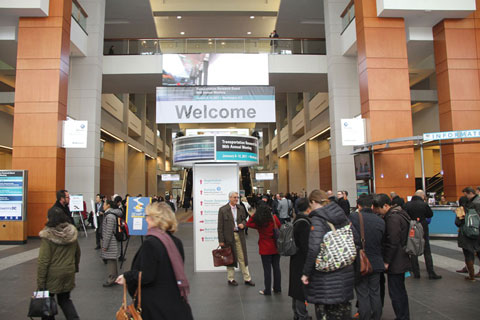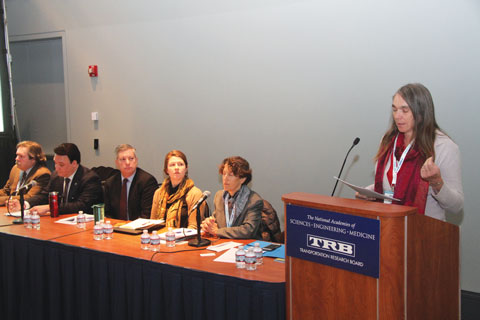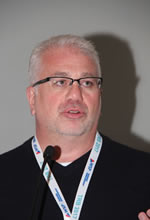
 A View from the Transportation Research Board’s 96th Annual Meeting |
By Hal Morgan
Executive Vice President Taxicab, Limousine & Paratransit Association
Rockville, MD
The Transportation Research Board’s 96th Annual Meeting was held in Washington, DC, January 8-12, 2017. More than 13,000 transportation professionals from more than 70 countries came to see roughly 5,000 presentations and 800 sessions or workshops covering all modes of transportation.
One of the more interesting and best attended session of the meeting was Traditional and Emerging On-Demand Transportation: Can We Live Together and Make Sure Everyone Is Served? The session was moderated by Annette Williams, the Manager of the Accessible Services Program for the San Francisco Municipal Transportation Agency (SFMTA), who opened the session with the following statement and question:
"Taxis and transportation network companies (TNCs) play an increasing role in public transportation service, primarily as additional, flexible capacity for public agencies. What are the advantages and challenges that face the agencies that try to take advantage of taxis and TNCs?"
The first speaker was Kate Toran, also from the SFMTA, where she is the Director of Taxis and Accessible Services. Ms. Toran said that the accessible taxi program in San Francisco started with four vehicles in 1994 and now features more than 100 ramp taxi vehicles. She noted that the key issue is that companies are finding difficulty recruiting and retaining drivers for these ramp taxis because of the competition from Uber.
The issue is that there are no limits to the number of vehicles that TNCs can have on the road and TNCs are lightly regulated with little enforcement of the regulations that are in place. On the other hand, she said, it takes a lot of work to make an accessible service work.
Currently, San Francisco provides a $10 per trip incentive to accessible taxicab drivers for every accessible trip they make. In addition, there is an additional reward for serving out of the way accessible trips - going to the head of the taxi line at the airport. She said that the city is considering a $0.10 per trip surcharge on all TNC and taxicab trips to be used for accessible service.
Ms. Toran was followed by Pasqualino (Pat) Russo, a partner in the New York law firm of Windels Marx Lane & Mittendorf, who also is an Adjunct Professor in the Masters in Public Administration Program at John Jay College of Criminal Justice.

Photo Credit: Wim Faber
Panel from left: James Nihan, Christian Kent, Pat Russo, Mollie Pelon; Kate Toran and moderator Annette Williams
Russo made a presentation on the report:
The Expanding Transportation Network Company (TNC) Equity Gap: Adverse Impacts on Passengers with Disabilities, Under served Communities, the Environment & the On-Demand Workforce.
He pointed out that the report, written by the former Commissioner of the New York City TLC, Matthew Daus, had been peer reviewed by a number of distinguished experts. This included Patricia Gatling, former New York State Deputy Secretary for Civil Rights, the longest serving New York City Human Rights Commissioner, and Isabelle Ducharme, Chairman of the Board at Keroul. Keroul is a Quebec based organization focused on making tourism and culture more accessible for people with disabilities.
Russo said there were five key takeaways from the report:
1.TNCs fail to adequately serve passengers with disabilities because they are not held to the same standards as taxis. This has resulted in more vehicles that cannot accommodate disabled riders, which has slowed or halted proposals to make taxicabs more accessible to disabled riders. He also noted that TNCs have argued they’re not bound by the Americans with Disabilities Act. He stated that UberWAV and UberASSIST were just marketing ploys.
2. The business models of TNCs result in redlining of low income, minority communities, and rural communities.Those areas typically have less access to credit cards and smartphones, and therefore, are not served by TNCs.
3. The devolution of sustainable transportation exists as TNC proliferation threatens cities’ efforts to reduce the number of personal motor vehicles on the road. This sets back decades of transportation planning and policy aimed at mitigating congestion and pollution, and encouraging shared mobility and mobility management. He said that congestion is further exacerbated by TNCs’ usage of "surge pricing" due to the incentive of TNC drivers being fiscally rewarded by working already congested areas during peak hours.
4. The lack of social corporate responsibility represented by TNCs because, while TNCs market themselves as socially responsible businesses, in reality they have built a highly sophisticated crafted web of tax avoidance depriving cities out of hundreds of millions in tax revenue.
5. The marginalization of the on-demand workforce because TNCs promote a contractor arrangement that has made their work forces both marginalized and under represented. The constant driver turnover and the majority of TNC drivers being part time has created a driver pool that is overly represented by inexperience with a direct negative consequence on safety and service quality.
Mollie Pelon is the Technology and City Transportation Fellow at the National Association of City Transportation Officials (NACTO). She is working on a project to develop data sharing standards, i.e., to elevate and standardize the process of data sharing. She said that an accommodation must be reached between Uber’s data sharing paranoia and reasonable data requests.
She discussed the World Bank’s Open Traffic partnership where three ridesharing companies, Easy Taxi, Grab, and Le Taxi, are working with the World Bank and others to make traffic data derived from their drivers’ GPS streams available to the public. It is being made available through an open data license which will empower cities to make better, evidence based traffic management decisions.
James Nihan, Senior Contract Administrator with the Massachusetts Bay Transportation Authority (MBTA) in Boston discussed the agency’s Paratransit Pilot Program. It used taxicabs to provide on-demand trips to ADA eligible paratransit clients.
During the taxicab pilot, for every $2 the customer spent using the MBTA provided Bank of America debit card, the MBTA paid an additional $13 on the card. If the ride surpassed $15, the rider had to pay the difference. The taxicab pilot ended on November 1 and currently there is an RFP out for a new taxicab paratransit program that would begin in February.
Mr. Nihan then discussed how the MBTA has joined forces with Uber and Lyft to create a paratransit pilot program. He said that there are 400 participants who have signed up to participate in the pilot program with 250 on the waiting list. This On-Demand Paratransit Pilot Program will allow the MBTA to learn and understand the opportunities and challenges of incorporating on-demand paratransit options using TNCs into public transit.
In concluding his remarks, Mr. Nihan stated that his number one concern was the safety of the MBTA paratransit riders and that any regulations that taxis or TNCs had to comply with were in place to provide a safety net to protect these riders.
Christian Kent, assistant general manager for Access Services, Washington Metropolitan Area Transit Authority (WMATA), provided the rationale of why Washington DC Metro is considering the use of transportation network companies to provide Metro Access services. He said that simple economics is causing Metro to explore the use of transportation network companies as alternatives to the Metro Access program.
The cost of the service and the numbers of people using the program are continually going up. He said that the door-to-door paratransit service provides about two million trips annually at a cost of about $121 million, and could increase by at least a million trips and more than $50 million in operating expenses in the next decade.
Partnering with other transportation services could potentially lower costs by half. He noted opposition and criticism from the disability community but stated that TNCs must comply with all local rules and regulations in order to participate in any Metro program.
Carol Tyson of the United Spinal Association’s Washington, DC office was the next speaker. She said that she was asked to be on the panel to represent the perspective of the disability community.
She said that there are 221 accessible taxicabs in Washington, DC, but she was concerned the lightly regulated transportation network companies were having an impact on the availability of these accessible taxis because they were contributing to driver shortages. She said inaccessible transportation alternatives like Uber and Lyft service caused to widen the accessibility gap.
She noted that Uber and Lyft are non-compliant with ADA and Title VI and continue to discriminate against people with service animals. She stated that the inequitable narratives of on-demand services only serving ambulatory passengers is not acceptable.
The final speaker on the panel was Bill George, President of the Taxi and Sedan Division of Transdev on Demand, Kansas City, Missouri. Bill stated that in 1903, transportation experienced a revolution as the horse and buggy were replaced by the automobile which offered speed, efficiency, comfort, job creation and freedom.

Photo Credit: Wim Faber
In 2013, on-demand transportation experienced a change as the taxicab was challenged by TNC companies. Was this revolutionary? No, it was evolutionary, Mr. George said.
TNCs have not changed the mode of transportation. They have just added a new way to do business. The main components of a taxi service are the driver, the car and the dispatching software. The main components of a transportation network company’s service are a driver, a car and the dispatching software.
The line between taxis and TNCs is becoming blurred. Mr. George stated that Transdev has introduced zTrip in 19 cities across the country. He said that zTrip is the future best option for paratransit work.
He said that incorporating TNC vehicles into taxicab fleets reduces fixed cost, offers expandable fleets, and greater efficiency through reduced deadheading and enhanced dispatching.
Mr. George explained, "Many contract customers don’t have access to a smart phone and require call center assistance. These same customers often rely on a 3rd party provider to manage their trip requests. The Transdev National Operating Center (NOC) allows us to offer this service without additional fixed cost investment."
He noted that 30% of the population cannot use or own a smartphone and that the zTrip National Operations Center was specifically designed for these calls. He then compared taxicab drivers with TNC drivers by saying:
"Many of taxi’s long term drivers work solely on contracted work. These drivers are experienced in providing the extra level of care required to perform the types of paratransit trips required by contract. The turnover ratio in this business type is the lowest among our driver pool."
This contrasts greatly, he said, with the TNC driver profile where driver turnover is more than 500% annually and there is no live training offered. Taxicabs can offer steady and predictable pricing for contracted work. The TNCs rely heavily on dynamic pricing in order to maintain driver supply.
By contrast, the taxi model is much better suited to maintain adequate supply in exchange for a steady and reasonable rate that can be guaranteed by contract. He concluded his remarks by discussing Transdev’s Taxi Butler booking device which allows doctors’ offices, dialysis centers and other paratransit client venues to use it as an on-location, one-touch device to call for a pick up.
2017 Spring Conference & Expo
Tuesday, April 25 - Friday, April 28, 2017
Hyatt Regency Indian Wells Resort & Spa
Palm Springs, California
2017 Mid-Year International Leadership Conference
Wednesday
July 12 - Saturday July 15
The Hotel Captain Cook
Anchorage, Alaska
99th Annual Convention & Trade Show
Sunday,
October 8 - Thursday, October 12, 2017
Hyatt Regency
Denver / Denver Convention Center
Denver, Colorado